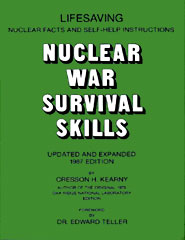Escape, Evade, Survive.
Information
Discussion Forum
Hunted: how to disappear without trace
Started by Central Scrutinizer Sep 19, 2015. 0 Replies 1 Favorite
Hunted: how to disappear without trace(…Continue
How To Make A Wood Gas Stove
Started by Misteri Apr 10, 2013. 0 Replies 0 Favorites
Materials Needed:1 Large Can (should be a short but fat aluminum can ranging from 22-28ozcan)1 Small Can (a typical Cambells soup can would do, they are slightly tall and skinny around 15oz can)1 Heavy Duty Scissors (or anything that could cut…Continue
Tags: self-sufficiency, cans, aluninum, sotve, wood
Survive this: Make a Garbage Bag Shelter Part of Your Survival Kit (Great Video)
Started by Misteri. Last reply by Misteri Apr 10, 2013. 1 Reply 2 Favorites
I’m not sure how the early settlers along the Oregon Trail or the western frontier got along without duct tape, WD-40 or trash bags, but life surely would have been easier with them!Trash bags, in particular, are included in all my survival kits.…Continue
The Best Bug-Out-Bag Essentials
Started by truth. Last reply by Anthony Kimbrough Apr 26, 2013. 6 Replies 6 Favorites
Survival Basics by russ kolkman
Started by J. Patriot Sep 28, 2012. 0 Replies 4 Favorites
Survival Basicsby russ kolkmanWhether you are out on a short day hike, canoeing, riding your ATV, hunting white tail or making a short flight; survival situations happen, and they can happen…Continue
The Most Important Question Survivalists Can Ask Themselves
Started by Nathan. Last reply by david james Nov 25, 2017. 2 Replies 6 Favorites
This article was contributed by Dan and Sheila at SurvivingSurvivalism.comHere it is – Why Are You Trying to Survive? With the news being what it is, the world has now come to the point at which a…Continue
A simple A frame Shelter to keep the rain and snow off of you.
Started by truth. Last reply by david james Nov 25, 2017. 1 Reply 3 Favorites
EDIBLE CITY: THE MOVIE
Started by truth. Last reply by Capt. Dave Mar 21, 2013. 1 Reply 3 Favorites
ABOUT | Edible City The Movieediblecitythemovie.com/about/Edible City, a 60 minute documentary film, tells the stories of the pioneers who are digging their hands into the dirt, working to…Continue
Earthship Biotecture Simple Survival Model
Started by guest_blog Aug 22, 2012. 0 Replies 4 Favorites
Total Collapse
Started by The Jackel. Last reply by david james Nov 25, 2017. 3 Replies 4 Favorites
TOTAL COLLAPSECan you Survive!We must all face the true facts of life and know we are never truly prepared to survive a total collapse in the United States. Unless your wading in greenback there is no way you could afford everything to assist your…Continue
Survival Topics
![]() Loading feed
Loading feed
Comment Wall
Comment
-
Comment by Joe Green on December 22, 2009 at 3:58pm
-
I'm happy to be a member of this group. Lot of great information here!
-
Comment by Nathaniel on December 17, 2009 at 9:07pm
-
Amen Greg, everybody better learn how to can, and have a secondary water supply, The water is really important because if you remember a few years ago they started finding drugs in the water like volume and other anti depressants, later we find that drug companies were dumping excess or outdated drugs in the water supplies. Well fast forward to now and there was a report last week that stated that 1 million doses of h1n1 have been removed from the supply and where do you think they will end up???
-
Comment by I811st on September 29, 2009 at 8:09am
-
Comment by peter b dunn on July 27, 2009 at 1:00am
-
this is all i could copy and paste sry
If two young women with a compass and limited tactical experience can get away with sightseeing in a military base over the course of 11 days without detection, there may need to be an inquiry into just how effective these training exercises actually are," Ms Bardon said.
The pair say they dodged helicopters, military dogs and avoided thousands of military personnel, making a mockery of the military's control of the area.
"The ideas that the military offers protection and that terrorism can be overcome with military means are in glaring need of revision," Ms Bardon said.
The pair entered the base on July 16 with five other activists in two groups.
In all, nine peace activists were arrested for non-violent protests during the exercises.
"These exercises are not just a 10-day long game of laser tag as... the media would have us believe," Ms Neilsen said.They represent Australia joining the United States in the illegal invasions of Iraq and Afghanistan where thousands of civilians have been killed."
-
Comment by peter b dunn on July 27, 2009 at 12:55am
-
http://news.ninemsn.com.au/national/842227/protesters-went-undetected-by-military,
awww so the link didnt copy so u can just click on it, above a story 2 protestors evade detection by military operation personell for 11 days in QLD Australia, good on em but they got done for tresspassing LOL may have to paste in into ya browser to see article...
-
Comment by truth on June 24, 2009 at 8:24pm
-
Comment by crashaxe on May 30, 2009 at 1:09am
-
you can use one of those filter straws works well
-
Comment by Dandy Andy aka flmkrdano on May 25, 2009 at 8:06pm
-
Living Without Refrigeration
Even if you are not striving for self-sufficiency, there are still good reasons to know how to live without relying upon a refrigerator
By Steven Gregersen
Some of the author's family's home canned food, they are (left to right); Apple Butter, Huckleberries, Huckleberry Syrup, Chicken, Mozzarella Cheese, Carrots, and Raspberries.
When we moved to our mountain homestead our goal was to be as self-sufficient as possible. That means absolutely no reliance on anything we can't make or acquire locally.
This doesn't mean we don't have anything powered by fossil fuels or electricity. It simply means that we can comfortably live without them as long as we need to.
For the first five years we lived without refrigeration, and even now our refrigerator is a novelty, a convenience we can easily do without. Its main purpose is to keep dairy products cold, and, now that the kids are mostly grown and gone, it's a place to keep the leftovers.
Even if you are not striving for self-sufficiency there are still some good reasons to know how to live without relying upon a refrigerator.
Refrigerators can quit at the most inopportune times. Hurricanes, wind, hail, floods, fires and freezing rain often leave large areas without power for days, weeks or months. Terrorism is a new threat that may someday leave entire grid networks without power. You don't know what the future holds so it pays to be prepared.
So, if you can't imagine life without the "fridge," here's how to not only survive without refrigeration, but to thrive without it.
We have three mainstays for long-term food storage at our home. The first is pressure canning, the second is drying and the third is our root cellar.
Canning
Canning plays a major role in food preservation at our house. As I write this we have in our pantry home-canned venison, beef, buffalo, rabbit, chicken, ham, bacon, sausage, salmon, carrots, green beans, peas, corn, milk, cheese, butter, stew, goulash, chili, meat loaf, venison and sausage patties, bear sausage, rhubarb, strawberries, huckleberries, plums, and apples. We also have jars of syrup, jams and jellies made from huckleberries serviceberries, raspberries and strawberries.
Canning is not difficult to learn or do but it must be done right. This is one place where mistakes can be fatal. Most canners come with instructions and include charts with cooking times and pressures for commonly canned foods.
Some of the author's home-dried foods. They are (left to right) rhubarb, black olives, corn, peas, garlic, broccoli, and yellow onion.
The Ball Blue Book is an excellent reference and is considered by many to be the canner's Bible. If you don't have a copy go to amazon.com books and type in "Ball Blue Book" or "canning."
While canning is a mainstay of food preservation at our house, we do have some objections to it. These are weight, space, money for jars and lids, and time.
There is a self life for the canning lids. After a few years you'll need to simmer them in hot water to soften them so they will seal. But the older the lid, the more the seal is likely to fail. If it came to a point where lids could not be replaced our canner would be useless. For this reason we've begun drying a lot of things that we used to can.
Dehydrating
Very little special equipment is needed to dehydrate food. In the summer we dry our food outside on raised screens. We put an oven rack on the picnic table. Lay a screen over it and put the produce on the screen and let it dry. If there are flies around we put screen over the top of the produce as well. Of course it has to be protected from the wind and rain.
You can purchase electric food dehydrators at any major department store. Their main advantage is speed. They work faster with artificial heat and a fan to circulate the air. We have two manufactured by Nesco. They work great. We use them on sunny days when the solar panels are at full output.
In the winter we place the food on metal screens near the bottom of the wood stove or hang racks with plastic screens from the ceiling. In most cases no special preparation is needed. You just slice the fruit, meat, mushrooms or vegetables thin and set them on the racks to dry. It costs nothing extra using this method.
"This is one of our drying racks we have suspended from the rafters near the wood stove," says the author. "The rack itself is a plastic shelf. We hang it to use as a platform for the plastic screen. We place the food on the screen when it's sliced and ready to dehydrate."
Be sure that you use a screen that's safe for drying food. Some foods, like high-acid foods, will react poorly with certain metals. Screens that rust can be hard to pry the dried food off of. Plastic canvas screens used by craft people provide a good dehydrating surface when placed on something firm but open, like an oven rack.
Dried food takes up a lot less storage space. The same amount of food that requires seven quart jars if canned will easily fit into a single quart jar when dried and weighs only a fraction of what one quart of canned vegetables weighs.
Another advantage of drying food is that it doesn't hurt it if it freezes. We can store it in outbuildings during the winter as long as it's out of the sun.
Dehydrated food takes a little more planning to use but the taste is just as good as canned food. It's especially handy when you're making stews or soups that'll be simmering on the stove all day long. You need to remember that a little goes a long way when using dried vegetables, so measure them out accordingly.
We often take home-dried food on our backpacking excursions to save weight and money. Dried pineapple, bananas, and apples make great snacks by themselves or they can be added to hot or cold cereal. Potatoes can be dehydrated and then re-hydrated and cooked when you make camp. Any kind of dried fruit you take along will make delicious pies. Just bring some sugar and cinnamon, baking mix for the crust and a reflector oven for baking it.
In our experience, dried food, when properly stored, will keep for years.
Root Cellar
Nancy and Mike Bubel's book, Root Cellaring: Natural Cold Storage of Fruits and Vegetables, should be in every homesteader's or survivalist's library. In my opinion, there is no easier way to store food than the root cellar.
In our root cellar we keep eggs, potatoes, turnips, carrots, squash, pumpkins, and apples. It's also a good place to store grains, nuts and seeds. We keep them in tightly sealed, plastic buckets.
Before we had our refrigerator we kept tea and canned pop in the root cellar for a cool drink on hot afternoons.
A good root cellar will keep things warm in winter and cool in summer. When it was thirty-below-zero last winter our root cellar stayed a toasty forty-plus degrees. In the summer it rarely gets above fifty in there.
The greatest thing about a root cellar is the ease of storing food. Unlike canning or drying, in which food often needs cleaning, cutting, blanching, etc., all you usually need to do to store fruit or veggies in a root cellar is put them in a bin.
A Nesco electric food dryer with one tray beside it to show the contents. The author's family has two of these units that they use at times in the summer. With the long sunny days their solar panels have the battery bank fully charged by 10:00 am. After that they have lots of excess electricity being generated so they put the electric food dryers to work. They are not any better than natural methods except for working faster due to their artificial heat and fans to circulate the air.
The shelf life varies according to what you're storing. Some varieties keep longer than others. Peruse the seed catalogues and select types that are best for long-term storage.
Root cellars, drying and canning are the three best, low-tech methods of long-term, non-refrigerated food storage but there are some other ways to preserve food that work well too.
In-Garden Storage
A lot of garden produce can be left in the garden. For example, an easy way to store carrots in your garden is to put a layer of leaves or straw over them to insulate then from the cold air. The thickness of the layer will vary according to how cold you expect it to get. It has to be enough to keep the ground from freezing or you won't be able to dig up the carrots when you need them.
Other methods involve stacking bales of straw or bags of leaves around or over crops in the garden. This will even work with tomatoes if you stack the straw alongside the plants and cover them with more straw.
You can also partially bury a barrel in the ground and store produce in it. Cover the barrel with insulating straw, dirt or leaves. Be sure you can get the lid off when you need to do so. It's like a mini-root cellar.
Door and Window Reefers
If a winter storm takes out your electricity, try putting those things that call for refrigeration next to an exterior door or an uninsulated window and covering them with a blanket. The blanket insulates the food from the heat inside the house while the cold on the outside chills the food. It works best on single-pane windows and uninsulated doors but even a double-pane window will keep food cold if it's protected from the warm air inside the house. Just be sure that the window is shaded from direct sunlight—preferably on the north side. If it's not you'll have a solar oven when the sun comes out.
We've had milk freeze solid using this method. When you want something, just pull the blanket back. It's convenient, cheap, and no special equipment's needed.
Basement Window Wells
If you have a basement you can use the below-ground-level window boxes as cold storage in winter. Build an uninsulated box or cover over the outside of the window well to protect the food from animals, dirt, debris and direct sunlight. Put the food in through the basement window and you have a mini-refrigerator.
The author's son Tristan feeding their chickens. During the darkest and coldest part of winter the chickens stop laying eggs. When spring comes and the days are getting longer they begin lay eggs again.
If the temperature in the window box is too high, hang a blanket or some other form of insulation over the window to shield it from inside heat. If it's going to get really cold at night leave the window cracked open to let heat from the house in.
Salting, Sugar Curing, Smoking and Pickling
Salt and sugar curing, smoking and pickling work as well today as they did hundreds of years ago.
Salt retards spoilage by drawing moisture out of meat and fish while simultaneously killing decay causing microorganisms. Salted meat stores well but tends to be tough and dry. For this reason sugar or honey is often added as flavor enhancers and to keep the meat moist and tender.
Salted foods can be a health hazard for people who are salt-sensitive and prone to high blood pressure and other salt-affected medical conditions. So use your own judgment as to whether this method of food preservation is right for you.
Smoking meat and fish is an ancient method of food storage. There are two methods of smoking. The most common today is hot-smoking in which the food is actually cooked while it's being smoked. It tastes great but hot-smoked food should be kept refrigerated.
Cold-smoking is the best for long-term storage. In this process the food is smoked some distance away from the heat source. The meat or fish is eventually coated with the smoke which kills or inhibits the growth of the things that can kill you.
I recommend some research on the long-term health aspects of smoked food before relying on it too much.
Salt-cured and cold-smoked foods keep best at around 55- to 60-degree (Fahrenheit) temperatures. They should be wrapped in brown paper and suspended in sackcloth bags for air circulation. The pieces should not touch anything else.
Even though we don't do pickling, it is a good way to preserve food. The high acidity eliminates any chance of botulism growth. Again, there may be health hazards involved, so research the subject and decide for yourself if this method works for you.
Greenhouses and Fresh Meat
Greenhouses enable you to extend your growing season in both directions.
With a greenhouse you can get an early start on your spring planting, but don't stop there. No matter which storage method you use your food will lose some vitamins and minerals. But, with a little planning and work, and a greenhouse, you can eat fresh food all year. Almost any crop you can grow in a garden can be grown in a greenhouse, so if you have one, use it all year long.
Tristan Gregersen coming out of the family's root cellar with a dozen eggs. When eggs go on sale they ometimes buy several dozen to keep for times when the chickens temporarily quit laying. The root cellar stores many other foods as well.
But vegetables aren't the only thing to think about when we speak of fresh food. We have chickens (fresh eggs and meat) and rabbits (fresh meat) that need no refrigeration at all. At some point in the near future we plan on adding to this list by acquiring a pig for meat and a cow for milk, cream, butter, yogurt and cheese.
So when you think about it, other than for making ice in the summer, why is it that you need a refrigerator at all?
Here are some of the books I'd recommend for the homestead or self-sufficient library in the area of food storage.
Back to Basics, The Reader's Digest Association, Inc., Pleasantville, New York 10572. It's a compilation of articles and ideas for those wanting to be self-sufficient. I call it "the idea book." Not enough information on any one subject to make you an expert but it covers about everything you'd need to know to become self-sufficient. It's my favorite book in our homestead library.
Root Cellaring: Natural cold storage of Fruits and Vegetables, Mike and Nancy Bubel, Stoney Communications, Inc., Pownell, VT 05261. This is the Bible of "natural cold storage of fruits and vegetables." It is my second favorite in our library.
The Foxfire Book, Anchor Books, Anchor Press / Double Day, Garden City, New York. (http://www.foxfire.org/index.html). We have the first six of the series. These are interviews of "mountain folk" who were still living the way their ancestors lived a hundred years before.
Living More with Less, and the companion book, More-with-Less Cookbook, By Doris Janzen Longacre, Herald Press, 616 Walnut Ave Scottdale, PA 15683 (724) 887-8500. These books contain a wealth of information gleaned from foreign mission fields and close-to-the-earth living practiced by the Mennonites.
Butchering, Processing and Preservation of Meat, By Frank G. Ashbrook, Van Nostrand Reinhold Company, New York, Cincinnati, Toronto, London, Melbourne. The author writes, "all phases of the preparation of meat, and meat products for home use, including slaughtering and dressing fresh and seasoned meat, cutting the carcass, refrigeration, curing, smoking, and canning, and the home tanning of hides and pelts are discussed in this book." It's another great one for the homestead library.
This is not an exhaustive list. These are all books we have in our own library and have found them to be full of good information. As of February, 2009, all of them were available for purchase online at amazon.com. l
Click Here
Contents copyright (c) 2009 Modern Survival Magazine
-
Comment by Dandy Andy aka flmkrdano on May 21, 2009 at 2:35pm
-
Comment by Dandy Andy aka flmkrdano on May 21, 2009 at 2:21pm
"Destroying the New World Order"
THANK YOU FOR SUPPORTING THE SITE!
Latest Activity
- Top News
- ·
- Everything
I joined Facebook after 5 years of suspension!!! It went as expected.
Who Were the Silver Ghosts and Fork Tailed Devils Over Germany in WWII?
THE GREAT FLOOD Official Trailer (2026) Netflix | Global Disaster Movies 4K
Mothman Prophecies
The 100 Series Designated for SAC and a Possible WWIII
Human Be-In - Full Program - 1/14/1967 - Polo Fields, Golden Gate Park (Official)
© 2025 Created by truth.
Powered by
![]()

















You need to be a member of Escape, Evade, Survive. to add comments!